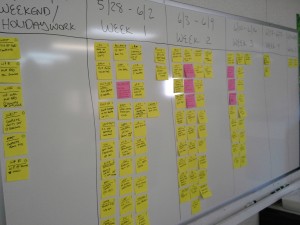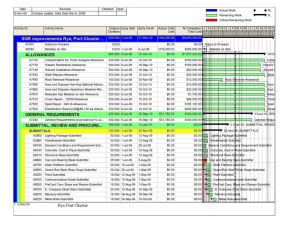As mentioned in this recent article on Planning and Managing Complex Construction Projects, the North Carolina construction industry is seeing a renewed interest in interactive planning techniques, especially pull planning. In a pull planning session, the people responsible for supervising the various aspects of the work into a room to answer one simple question
What do we have to do, and when, to meet the project’s completion date?
A simple question but not a simple answer. Pull planning techniques involve using sticky notes to mark essential elements of work, working backwards from the end-date. A large white board is used with a timescale on top. The time scale is usually broken down by weeks (Week 1, Week 2, etc.). It’s effective because it uses key players to define and sequence work tasks needed to get the work done and avoid delays.
In the past two weeks I have attended two pull planning sessions involving Florida theme park construction projects. Both projects were in their final stages and under strict deadlines. Pull planning is very effective in these scheduling scenarios as everyone can agree on the common goal of completing the remaining work so as to finish the project on time. Here are 4 key points I took away from these sessions.
- Get the right people there. The pull planning session should be made up of the people who supervise construction on a daily basis – not the crew foremen or the supervisor’s supervisor. You need the people who know the workers, equipment, and materials and know what can and cannot actually be accomplished.
- No substitutes. Having a substitute for a key individual definitely hampers the ability to complete the pull planning session. In short, hearing “I’ll have to get back to you on that” over and over just doesn’t cut it.
- Promote a global understanding. Everyone needs to thoroughly understand the work. Not just their own scope of work but the scopes of work of other trades. Why? Because on a construction project the various trades are inter-dependent on one another and each individual must know the preceding and succeeding trades to contribute.
- Lay down the Conditions of Satisfaction (COS) first. Every attendee must be on board for which COS are required to meet the deadline. The difference between what is 100% required for COS what may not be required is important so that the right resources can be assigned to the right tasks without any wasted effort.
Pull planning is a very effective technique for outlining and meeting scheduling deadlines for construction projects. When handled correctly, pull planning eliminates miscommunications and allows every key player to be integrally involved in the planning process. Try different colored stickies for the various trades so people can quickly and easily visualize where their part of the plan falls within the whole of the project.



